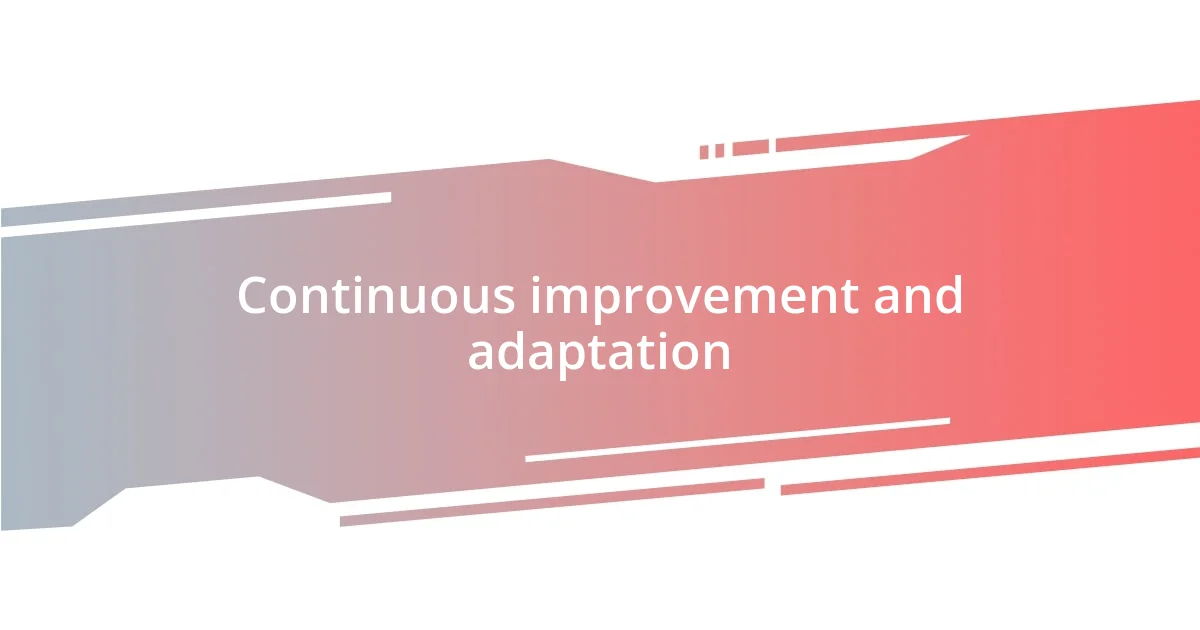Key takeaways:
- Involving team members in discussions about standards fosters shared ownership and transforms compliance into collaboration.
- Aligning personal goals and core values with new standards enhances commitment and enthusiasm among team members.
- Embracing flexibility and celebrating small victories during the implementation process promotes continuous improvement and a positive team culture.

Understanding adoption of standards
Understanding the adoption of standards is vital for any organization. I remember when my team decided to implement a new set of industry standards. At first, there was resistance; people feared it would add complexity to their work. It made me wonder, why do we often equate standards with rigid constraints instead of viewing them as frameworks for enhancing creativity and efficiency?
As I’ve delved deeper into the process, I’ve come to appreciate the emotional journey that accompanies this adoption. There’s a sense of vulnerability when we let go of old ways and embrace new methods. For me, this process felt much like navigating unfamiliar waters, but eventually, we found ourselves steering confidently with clear benchmarks to guide us.
Moreover, the success of adopting standards lies in understanding their relevance. I’ve seen firsthand how involving team members in discussions about standards not only eases apprehension but also fosters a shared ownership of the changes. After all, isn’t it enlightening to consider how inclusive dialogue can transform compliance into collaboration?

Identifying personal goals and values
Identifying personal goals and values is a crucial step in the journey of adopting standards. In my experience, taking the time to articulate what truly matters to me has created a solid foundation for embracing new principles. When I prioritized values like transparency and teamwork, I noticed that every decision I made felt more aligned with my core beliefs, making the transition smoother and more meaningful.
I recall a moment when I was revising my team’s objectives. I realized some goals were merely checkboxes rather than ambitions that resonated with my values. This insight was transformative; by reshaping objectives to reflect my priorities, I unlocked a deeper commitment from my teammates. It’s fascinating how aligning goals with personal values spurs enthusiasm and dedication among everyone involved.
Often, I ask myself: What drives my daily choices? Reflecting on this has opened my eyes to better understand my motivations. When I engaged my colleagues in similar conversations, we discovered shared values that galvanized our efforts. This collective journey not only strengthened our bonds but also laid the groundwork for successfully implementing the standards we aimed to adopt.
| Personal Goals | Core Values |
|---|---|
| Career advancement | Integrity |
| Work-life balance | Collaboration |

Researching relevant standards
Researching relevant standards can feel overwhelming at first, but I find that focusing on the right resources simplifies the process. When my team was exploring new standards, I turned to a mix of industry publications, online databases, and expert forums. This multifaceted approach not only enriched my understanding but also allowed me to see varying perspectives on the same standards.
- Identify industry-specific organizations that publish standards.
- Utilize online databases, like IEEE Xplore or ISO, to access research.
- Engage with communities on forums or social media to gather real-world experiences.
- Keep notes on any standards that resonate with your goals and values.
I remember spending hours sifting through documents, each filled with dense information. However, it was those informal discussions with colleagues that proved invaluable. They shared their own experiences of implementing standards and what worked—or didn’t work—for them. This knowledge sharing not only enriched my research but also built a camaraderie that made the process feel less daunting. When research feels like a shared journey, it transforms into an opportunity for collaboration and growth.

Creating a structured implementation plan
Creating a structured implementation plan is essential for turning aspirations into realities. I’ve personally found that breaking down larger standards into manageable, actionable steps makes the entire process feel less intimidating. For instance, when I tackled a new compliance procedure, I mapped out each phase on a timeline, which not only offered clarity but also ensured that my team stayed on track and engaged.
As I moved through the planning stages, I frequently checked in with my team. This wasn’t just about assigning tasks; it was about fostering ownership and accountability. I remember one team member expressing hesitation about a deadline. Instead of brushing over that concern, I created space for discussion. By revisiting the plan together, we adjusted timelines and rediscovered our shared motivation, which strengthened our commitment to the overall goal.
I often reflect on the balance of structure and flexibility in any implementation plan. How do you maintain momentum while allowing room for adjustments? In my experience, it’s essential to remain adaptable. When unforeseen challenges arose, I encouraged an open dialogue about how we could pivot without losing sight of our objectives. This responsiveness not only enhanced our resilience but also cultivated an environment where everyone felt empowered to contribute their ideas.

Overcoming common adoption challenges
Navigating the challenges of standard adoption can sometimes feel like traversing a maze. When I first introduced a new standard at my workplace, resistance was palpable. I remember one particularly vocal team member expressing skepticism about the necessity of these changes. Instead of dismissing their concerns, I organized a dialogue to address everyone’s thoughts. This approach not only diffused tension but also allowed us to see the potential benefits through a collective lens, greatly easing the transition.
Another obstacle I faced was aligning diverse perspectives within the team. I vividly recall a project where differing opinions on the standard’s application initially derailed our progress. To bridge these gaps, I initiated brainstorming sessions that encouraged everyone to voice their ideas. This not only provided a platform for creativity but also highlighted the importance of collaboration. Through this process, we transformed our differences into strengths, creating a more cohesive strategy for implementation.
Moreover, ongoing training and support are crucial in overcoming adoption hurdles. When we rolled out new tools related to the standards, I made a point to be actively involved in the training sessions. I asked participants to share their experiences and challenges in real-time, fostering a culture of learning. By investing time in understanding their struggles, we were able to adapt our approach and make necessary adjustments. This proactive engagement not only built trust but also invigorated our collective efforts, making the adoption process feel like a team victory rather than a solo endeavor. Wouldn’t it be amazing if every challenge we face could be transformed into a stepping stone for growth?

Measuring success in adoption
Measuring the success of adoption requires both quantitative and qualitative approaches. I’ve often found that metrics like compliance rates and feedback surveys can offer valuable snapshots of progress. During one project, we tracked our team’s understanding through assessments, and it was rewarding to see scores improve as familiarity with the new standards grew. However, I’ve learned that numbers alone don’t tell the whole story; they need to be supplemented by genuine conversations with team members about their experiences and challenges.
Furthermore, I emphasize the importance of monitoring long-term impact. After implementing a new standard, I like to revisit the changes months later to assess their effectiveness. One time, I followed up with a team member who initially struggled with a new procedure. To my surprise, they expressed how much smoother their workflow had become, fundamentally changing their daily experience at work. This moment reinforced my belief that a standard’s true success lies in its ability to enhance daily operations and team morale.
Ultimately, I believe success should also be reflected in the culture surrounding the standards. Are team members excited about the changes, and do they feel empowered to contribute? I once held an informal check-in where a few colleagues shared innovative ways they had adapted the standards. Their enthusiasm was contagious! This interaction highlighted that adopting standards is not just about compliance; it’s about creating an environment that fosters innovation and collaboration. So, how do we cultivate that excitement? By continually engaging with our teams and celebrating the small wins along the way.

Continuous improvement and adaptation
Embracing continuous improvement and adaptation has been a game changer for me in the adoption of standards. I remember a time when we implemented a new protocol that initially felt rigid and daunting. One afternoon, as I was reviewing our progress, I noticed some team members gravitating back to their old methods. Instead of enforcing compliance, I gathered the group for a reflective session where we discussed what was working and what wasn’t. This open dialogue sparked a wave of innovative solutions that truly tailored the standards to fit our unique workflow, leading to greater efficiency and morale.
As I moved forward with implementing new standards, I realized that flexibility is just as essential as structure. For instance, there was a project where mid-way through, feedback revealed that several team members were struggling with a particular process. Instead of pushing ahead with the original plan, I made the decision to pivot, allowing us to redesign the approach based on real feedback. This willingness to adapt not only improved our working methods but also instilled a sense of ownership among the team. They saw their voices were valued in the process and began taking initiative, which fundamentally shifted our collective mindset.
I find that celebrating small victories fosters a culture of continuous improvement. One day, after a particularly successful adaptation of our standards, I surprised the team with a small recognition ceremony. As I handed out little tokens of appreciation, I noticed a sparkle in their eyes that indicated more than just gratitude. It was as if they felt seen, and that their efforts mattered. When team members feel recognized, they’re more likely to contribute actively to ongoing improvements. So, how do we ensure that we keep this momentum going? I believe it’s about creating an environment where adaptation is celebrated, and lessons learned from setbacks are viewed as stepping stones rather than roadblocks.












